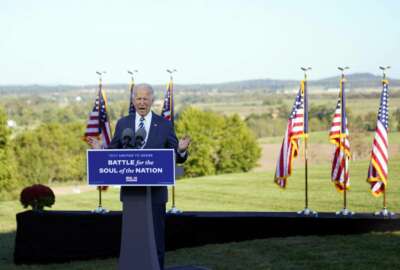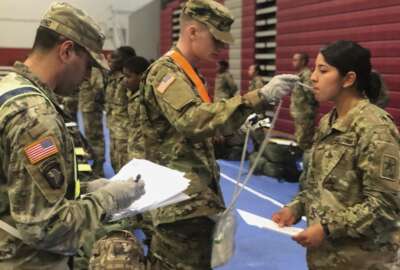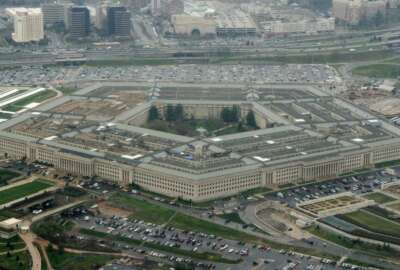
How the new National Defense Strategy is being received in areas with lots of contractors
When the Pentagon released its latest four-year National Defense Strategy, it became a must-read for contractors and their associations. To find out more about ...
Best listening experience is on Chrome, Firefox or Safari. Subscribe to Federal Drive’s daily audio interviews on Apple Podcasts or PodcastOne.
When the Pentagon released its latest four-year National Defense Strategy, it became a must-read for contractors and their associations. To find out more about how it is being received in one region with a substantial defense economy, the Federal Drive with Tom Temin spoke with retired Marine Corps Lt. Gen. Mark Faulkner, who is now president of the Institute for Defense and Business.
Tom Temin: Your organization focuses on leadership development. So is there some line you can draw for us between the latest strategy, the latest four year strategy and leadership needs that you think might be required in the military complex?
Lt. Gen. Mark Faulkner: Yeah, Tom? Absolutely. You know, as I read through the Defense Strategy, it clearly lays out the challenges that our nation is going to face over the next 10 years. And it does a good job of not sugarcoating the seriousness of the threats and the challenges, whether it’s the peer competitor of China, whether it’s what Russia and their aggression’s doing, Iran, North Korea, I mean, a whole host of challenges. And Secretary Austin really has stated that, look, we’re not going to be able to do this with business as usual, and what that means. And that’s where it comes close to home for us at IDB. What that means is that, you know, our leaders can’t do business as usual; they need to be more prepared to take on these challenges. And that’s where we come in: Actually preparing these leaders, shaping these leaders, so they can solve these critical problems that our nation is going to be faced with. So we’re continuing to design and deliver these custom education solutions, at IDB and it’s even going to be more important going forward in the future.
Tom Temin: Yes, let’s maybe back up for a moment. Tell us a little bit more about IDB’s mission and how it works functionally. Where does the education get delivered and who comes to receive it?
Lt. Gen. Mark Faulkner: At the end of the day, of course, we’re a nonprofit, we’re located in Chapel Hill, North Carolina. We’re about 25 years old as an organization. And we were born right here in North Carolina, we have a relationship with UNC Chapel Hill for some of our programs. But really over the last 20 to 25 years, over 10,000 leaders, from Defense, from government, from private industry have come through our programs. We’re right about 85% DoD, mid- to senior-level leaders, majors, lieutenant colonels all the way up to generals and admirals, GS-6s, GS-7 government civilians, all the way up to senior executive service individuals, and from private industry, vice presidents of some of the top name defense contractors, Northrop Grumman, Boeing, and others. But they come together across 10 to 12 of our program offerings, and a lot of logistics underpinning. But they focus on critical problem solving. And they walk away from our programs equipped with tools to make them better equipped to do that. The last thing I’d say to you is that it’s really unique in bringing government together with private industry where private industry is able to share the best business practices, which is something that Secretary Austin is very interested in doing, is making sure that whether it’s Defense or industry, we share these perspectives.
Tom Temin: And let me ask you this: I mean, a lot of requirements have been laid on military leaders in recent years, probably more than when you were serving. They have to be concerned with diversity, equity, all of these questions, they also have to worry about climate types of effects on operations and on establishments, military bases, posts, and so on. I mean, even the systems are changing. I saw one at the Army show, this new proposed tank — it’s just a prototype — has batteries. It’s like the world’s most badass Prius that was ever built, not bought yet. But these are the kinds of things that have to concern military leaders as much as, as they used to say, breaking things, killing people, winning the nation’s wars, and so forth. So how does that translate into leadership requirements?
Lt. Gen. Mark Faulkner: Yeah, it’s a great point, this issue of change in culture is very important. But I’ll tell you what I would add on to that. And something that, again, is in the National Defense Strategy is this issue of integrated deterrence. And so today, and tomorrow’s problems are more complex than they ever have been, not only because of the competitors that I named earlier, but the collapsing of domains where diplomatic and economic and military comes together. The challenges associated with cyber, with technology, with autonomous vehicles, with information. So my point is that this is different than it was even a decade ago when I was still wearing the uniform which, frankly, is going to require our leaders to be smarter, whether it’s military or civilian, and solve more difficult problems. So not only some of the ones you named, but I would argue the others that really cover tactical, operational all the way through strategic, those leaders need to be able to do that and they need to be able to do it quickly, because time is going to matter on tomorrow’s battlefield.
Tom Temin: We’re speaking with Mark Faulkner. He’s president of the Institute for Defense and Business, and a retired Marine Corps Lieutenant General. And is there any way that this can translate, I don’t know, downstream or upstream, I’m not sure what the right word is. But the recruitment challenge that the military services face is pretty substantial and worrisome. Because you can’t field the end strength that even Congress requires if you don’t have the raw material coming in. And part of it is the state of the nation’s raw material, you could go on and on about that one. But can any of this idea of the new way of thinking, this creativity that leaders need, somehow be used to show ‘Hey, this is a place you might want to be for your career, or at least part of your career?’
Lt. Gen. Mark Faulkner: Well, I think it really does. And you know, the young men and women of our nation, they need to be incentivized. And they need to know that they’re not only joining our military to support our great nation, but it needs to be interesting. And there needs to be something there for them. And we need to work hard to do a better job. And I can talk about that as well, you might be surprised that I have some opinions on how well we’re doing with developing our people. But look, they need to know that there’s something for them, whether it is innovation, whether it is the importance of data, whether it is something that they can take from the military out to the private industry. So the days of just saying ‘shut up and color, put on a uniform,’ look, that’s not going to get it anymore. We need to be more thoughtful in the way we incentivize. And we offer opportunities to young men and women of the importance of the military.
Tom Temin: Now your own organization, the Institute for Defense and Business has established some partnerships with other national groups to try to do what exactly?
Lt. Gen. Mark Faulkner: Yeah, we have, and it’s interesting. It’s not necessarily a, perhaps, a good parallel. But as the defense strategy talks about allies and relationships, we see that the same way at IDB. We need allies and relationships to be even stronger. So we’re doing that with, for example, the Defensive Alliance of North Carolina, that is wrapping their arms around all these terrific defense industries across this great state. We’re doing it with the National Defense and National Transportation associations. We’re doing it with the Defense Acquisition University, and frankly, we’re doing it with the Office of the Secretary of Defense. We have one with the University of North Carolina now. But frankly, we feel that we could be stronger, together with other organizations to get the word out and do better in terms of marketing, and just getting more leaders into our programs.
Tom Temin: There have been lots of published stories, lots of analyses lately about whether the United States military edge is eroded to a dangerous level, whether the readiness is there, whether the platforms we have are adequate for what might be ahead. And yet the second tier, if you will, of leadership, in the military services is largely unseen and unknown to the public. Everybody knows who Lloyd Austin is, and so forth. And we know the Chief of Staff of the Army, those are people that are out there. What’s your sense of the readiness of those people operating below the publicity lines, but are really the next generation of the top people? Are they up to what’s ahead?
Lt. Gen. Mark Faulkner: Well, if the individuals coming through our programs are any indication, Tom, I would say simply, yes. I’m very encouraged. I’m very encouraged, whether it’s the young lieutenants, the captains, even the Master Sergeants [and] Sergeants Major that come to our courses, and they have a lot of drive, they have a lot of energy. They’re smart as hell, and their work ethic is just tremendous. But I gotta tell you, we can do better. And we can do better as a nation. And you look at Secretary Austin’s priorities, he was pretty clear that people is one of his top priorities. But where we’re still falling short — and I gotta look in the mirror, and I could have done a better job when I was on active duty — we’re still falling short of investing in our people. It’s easy to invest in things, missiles, nuclear deterrence, all the capabilities that are laid out. But when it comes to investing in our people, our talk is not matching our resource. And we got to do better, we must do better if we’re going to deliver on what’s laid out in the National Defense Strategy.
Tom Temin: And does that also extend to the civilian workforce, which is often overlooked as a really crucial part of all of this? I’ve come across some individuals on the civilian side in DoD, just doing amazing leading edge work in acquisition, in artificial intelligence, and ways of just speeding up everything and they’re not at all squeamish about doing this for the military purpose.
Lt. Gen. Mark Faulkner: It does apply, but I will tell you that the defense industry, DoD in particular, is really doing well in that area, compared to how they’ve done in the past. There are pockets of success, I will tell you. So let me give you a couple of examples. The Army, in terms of their civilian career force management, is tremendous. They’ve just recently published an implementation plan that clearly lays out objectives and goals for the future. And they are actually resourcing and putting money against it. I mentioned the honorable Chris Loman, the assistant secretary of Defense for sustainment; he is working hard to actually get it in their palm, as opposed to just paying it out of the daily operational budget. One last one would be the DLA, the Defense Logistics Agency, and United States Transportation Command. [Vice Adm.] Michelle Scubik and Gen. [Jacqueline] Van Ovost at TRANSCOM are actually putting money against their civilian workforce in particular. More than ever, we’ve recognized how important those folks are. Frankly, they’re the continuity as folks like me in military uniform bounce around across the nation, they stay in position sometimes for 15, 20, 25 years. So it’s important that they’re educated and professionally developed as well.
Tom Temin: Alright, so sounds like you’re optimistic.
Lt. Gen. Mark Faulkner: I really am. But it doesn’t mean that we can’t be better. And it doesn’t mean that we don’t have work to do if, in fact, we’re going to deliver on these challenges that are laid out in the National Defense Strategy.
Copyright © 2024 Federal News Network. All rights reserved. This website is not intended for users located within the European Economic Area.
Tom Temin is host of the Federal Drive and has been providing insight on federal technology and management issues for more than 30 years.
Follow @tteminWFED






